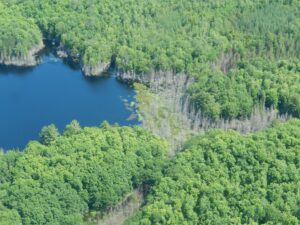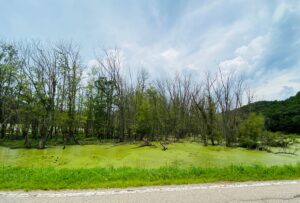Mike Hillstrom, forest health specialist, Fitchburg, Michael.Hillstrom@wisconsin.gov, 608-513-7690
Wisconsin has had historically wet weather the last five years, and the impacts to trees are escalating. Forest health staff have noted significant mortality of trees along lakes and rivers from rising water levels. Trees growing in low areas that have not flooded in many years are also being impacted.

Rising lake water levels causing conifer mortality.
In seasonally flooded forests, the compounding stresses of staying wet longer into the growing season, often for several consecutive years, is now leading to tree decline and mortality. In some cases, the water alone is killing the trees. In other cases, the water stress is allowing insects and diseases to attack the weakened trees and kill them.
Early color change is a common symptom of water stress. Even silver maple and tamarack are succumbing to flooding at some sites. In addition to the stress from flooding, wet ash sites are seeing rapid mortality from emerald ash borer infestation in southern Wisconsin. These ash sites are rapidly converting to non-tree vegetation, including invasive species such as cattails and reed canary grass.

Ash trees dying from repeated flooding and emerald ash borer infestation.
Where possible, continue to conduct salvage harvests of flood-impacted stands. However, the list of complications for harvesting wet sites is long (e.g. difficult access even during winter, low wood value) and trying to maintain forests in some areas may not be possible.
